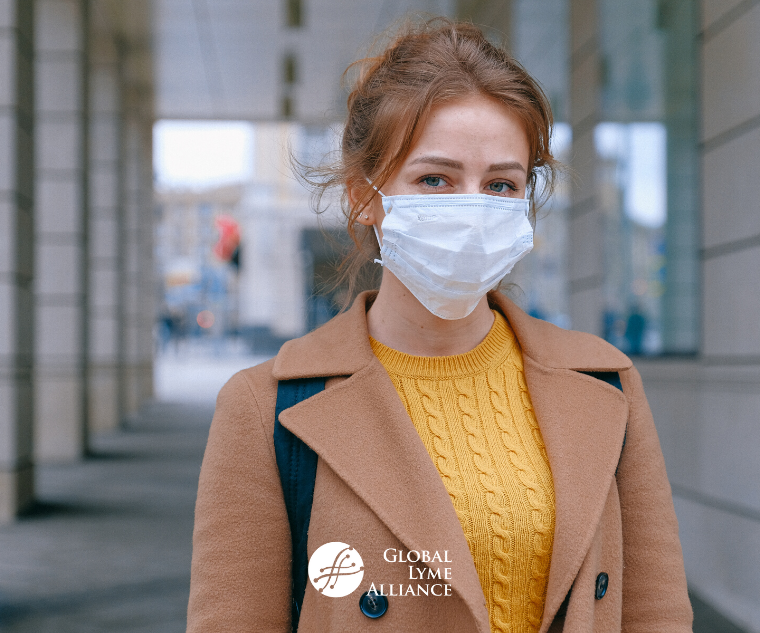
by Jennifer Crystal
I have been battling COVID-19 symptoms for almost five weeks. I have had Lyme disease and two tick-borne co-infections—babesia and ehrlichia—for twenty-three years, though my tick-borne diseases went undiagnosed for the first eight of those years. Having COVID-19 on top of tick-borne illnesses has been nerve-wracking, but as I explained in my Corona With a Twist of Lyme: Part 1, it has also been for the most part manageable.
This post is an update on how I’m doing and what I’ve learned so far, which I hope will have relevance for my fellow Lyme warriors. I’ve realized there are many similarities between fighting Lyme and COVID-19, and I hope that discussing them here will give Lyme patients hope and strength in a time of fear and uncertainty.
At the time of my first post, I’d been sick for two weeks. The first week had progressed as many mild to moderate COVID-19 cases have; it started with vomiting, then a night later I developed fever, then on the day after that, a dry cough and shortness of breath. Those symptoms persisted for the first week. Then the fever broke, and stayed away for the second week, and the cough lessened. Shortness of breath became less apparent. It seemed I was getting better and nearing recovery.
Then, as with Lyme disease, the novel coronavirus threw me a curve. At the start of the third week, my low-grade fever suddenly returned, and the cough became deeper and more frequent. That weekend, I lost my sense of taste, and then my sense of smell. It is not like when you have a cold and those senses are dulled. Right now, for instance, I can’t detect flavors, though I am starting to be able to tell if something is sweet or salty or bitter. Smell, on the other hand is completely gone. I hold spices, scented candles, cans of tuna, and brown bananas under my nostrils. I smell absolutely nothing.
“Doesn’t that usually happen at the onset of COVID-19?” one person asked me. For some patients, it is a first or only sign of COVID-19. For others, the loss of taste or smell symptoms develop later in the disease progression, sometimes a week in, sometimes two or even three weeks in. A family member of mine who tested positive for COVID-19 lost her sense of taste and smell at about the same point in her infection as I did. She got it back a week later.
I’m still waiting for mine to return, but I’m not worried. Because of my underlying conditions (in addition to three tick-borne diseases, I also have chronic Epstein-Barr virus), it always takes me longer than the average healthy person to get over an acute illness. Sniffles for one person can be a multi-week cold or sinus infection for me. But the important part is that I always get better, and my doctors have full confidence that I’ll beat COVID-19, too. It’s just going to take time.
I’ve written in the past about healing not being linear, especially with the ups and downs of tick-borne illness. I realize that the same is true for my COVID-19 recovery. My fever has gone away, and has then come back, and gone away again. My cough has gotten better, then worse, then better again. Each new wave brings fatigue and frustration, but it also brings me a step closer to recovery. The periods between fevers are becoming longer. I hardly notice my shortness of breath now, unless I’ve been teaching (remotely) for hours or I exert myself. When I was at a low point with Lyme, it was hard to see that I was still making progress, incremental though it was, I was in fact doing so. That experience helps me to see how I’m slowly making progress with my COVID-19 recovery, too.
Others have lost their battles with COVID-19, and my heart goes out to their families. I recognize that even though my case has dragged on, I have been lucky. COVID-19 may impact an acute Lyme patient differently than a normal healthy person. Though there’s great variance in how each person’s immune system responds to COVID-19, too little is known about it, just as too little is known about how each Lyme patient will react to Lyme treatment. But we can’t let a fear of worst-case scenarios overpower us. That type of anxiety is a feeding ground for spirochetes, the bacteria that causes Lyme.
I want to say again that so far, COVID-19 has not noticeably impacted my underlying infections. I haven’t had a flare-up of Lyme achiness or joint pain, or neurological impairment. The fatigue of COVID-19 feels like the fatigue I’d usually feel with a cold or the flu, not the tormenting fatigue of Lyme. My doctors can’t yet say how COVID-19 will affect my underlying infections in the long-term. With Lyme disease, there are so many unknowns, but right now I feel like I’m anecdotal proof that a Lyme warrior can weather a mild to moderate case of COVID-19.
If you’d like to hear more about my experiences with Lyme and COVID-19, watch the Q&A webinar I did with Dr. Cameron on April 16th.
Be well, fellow Lyme warriors.
Additional COVID-19 and Lyme Disease Resources:
Blog: Corona With a Twist of Lyme: Part 1
Blog: Corona With a Twist of Lyme Part 3
GLA POV: Parallel Pandemics: COVID-19 and Lyme Disease
Blog: Q&A on COVID-19 and Lyme Disease with LLMD
Letter: GLA CEO Addresses COVID-19 and GLA Community

Opinions expressed by contributors are their own.
Jennifer Crystal is a writer and educator in Boston. Her memoir about her medical journey is forthcoming. Contact her at lymewarriorjennifercrystal@gmail.com.

Jennifer Crystal
Writer
Opinions expressed by contributors are their own. Jennifer Crystal is a writer and educator in Boston. Her work has appeared in local and national publications including Harvard Health Publishing and The Boston Globe. As a GLA columnist for over six years, her work on GLA.org has received mention in publications such as The New Yorker, weatherchannel.com, CQ Researcher, and ProHealth.com. Jennifer is a patient advocate who has dealt with chronic illness, including Lyme and other tick-borne infections. Her memoir, One Tick Stopped the Clock, was published by Legacy Book Press in 2024. Ten percent of proceeds from the book will go to Global Lyme Alliance. Contact her via email below.






